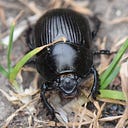How to Tell the Difference between Bees, Wasps, and Flies
Which of these is a bee, a wasp, and a fly? Answers at the end of the article!
Bees, wasps, and flies are all insects, and can look remarkably similar. But even species that look almost identical have some subtle differences, and telling the difference can reveal a whole world of biodiversity that is often hidden. Learning to identify different groups of species is an important step in gaining a greater appreciation for wildlife, which in turn is an important step in preserving it.
Bees and wasps are related, both being types of hymenopterans. Flies belong to a different group, and are also called dipterans (which means two wings), giving a clue to one of their biggest physical differences from bees and wasps, which is the fact that they have only two wings. Meanwhile, bees and wasps, like many other insect groups, have four wings. Confusingly, there is another group of hymenopterans called the sawflies, which tend to look similar to wasps but lack a defined “wasp waist”.
A clear and distinctive feature of flies is their eyes. Flies usually have huge eyes, with some having eyes that are so big that they touch on top their heads. Wasps and bees can also have large eyes, but they’re still usually smaller than those of flies.
Flies feed using mouthparts adapted for sucking up liquid food. You’ve probably had experience with this when shooing a housefly off your sandwich or becoming the victim of a blood-sucking mosquito. While bees and wasps also feed on liquid food and have a long “tongue” for doing so, they also have biting mandibles that are used for chewing. Looking closely at their faces, you can see the different mouthpart arrangements and a slightly different shape of the face. Additionally, flies’ antennae (feelers) are usually very short and have distinctive lobes at the base. Bee and wasp antennae are longer and often have a sharp bend, like an elbow.
Some of the biggest differences between the groups are found in their social behaviour (or lack thereof). Flies are not social insects and are solitary, whereas bees and wasps show a large range of social behaviours. The most familiar is the strongly social behaviour of honey bees, which live in large colonies that can last for several years. Wasps may also be social, such as the infamous yellowjacket. However, the majority of bee and wasp species are not social. Bees and wasps, social and solitary alike, also carry out complex building behaviour to create nesting sites.
Bees are largely herbivorous, feeding on pollen and nectar, while flies and wasps are omnivorous, and their diets range widely depending on the species.
Flies are fond of pretending to be bees or wasps, and some are quite good at it. For example, in Europe, Pocota personata and Volucella bombylans look almost exactly like bumblebees (V. bombylans even has two different forms, mimicking two different species of bumblebee). The most prominent species to do this are the hoverflies, and these are the flies this article is most applicable to. The main giveaways for these flies are the large eyes and the single pair of wings, if you look closely.
So, when you see an insect and you’re not sure if it’s a bee, wasp, or fly, look out for the following things (note that these points almost always have exceptions, but are a good place to start):
· Wasps have a distinctive narrow “wasp waist”. While bees and flies may also have a narrow section between the front half of the body and the back half (the thorax and abdomen), it is most pronounced in wasps.
· Flies have enormous round eyes in comparison to bees and wasps and may even touch on top of the head. From the front, the eyes of bees and wasps appear more oval shaped.
· Bees and wasps have relatively long and noticeable antennae on the head, while those of flies tend to be very small.
· Looking closely, flies tend to have round faces, whiles wasps have more triangular faces. Bees are often somewhere between the two.
· Bees and wasps have four wings, while flies only have two, although this can be difficult to spot.
· Bees are often fuzzy, while wasps and flies usually look smooth and shiny. However, some hoverflies look remarkably similar to bees and may also be hairy.
· In many species of wasps, the females have a long ovipositor, which is a tube at the end of the abdomen that’s used for laying eggs. While bees and flies also have one, it usually isn’t as visible. In stinging species of bees and wasps, the stinger is a modified ovipositor.
· All three groups can often be found feeding on flowers, but flies also spend a lot of time sitting on leaves and other flat surfaces, while bees and wasps usually don’t.
· When flying, bees and wasps often curve their bodies slightly and their legs may hang down. Flies usually fly holding their bodies straight and keeping their legs tucked in. Of course, hoverflies also hover, and this behaviour occurs as part of courtship in some species.
Answers, from left to right: fly (note large eyes and small antennae), wasp (note large antennae and “wasp waist”), bee (note large antennae, hairy body, and lack of a “waist”).
All images are public domain unless attributed.
